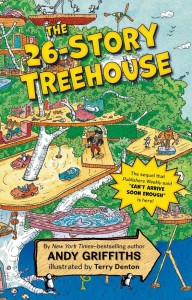2018 School Spending Survey Report
Q&A: Author Andy Griffiths on His Ever-Growing 'Treehouse' Series
The 26-Story Treehouse author spoke to SLJ about the treehouse of his childhood, punk rock, advice for young writers, and more.

Author Andy Griffiths/Library Journal
With his latest work, The 26-Story Treehouse (Feiwel & Friends, 2014), a laugh-out-loud book crammed with illustrations and aimed at middle-grade readers, punk rocker-turned-author Andy Griffiths does more than entertain. This sequel to The 13-Story Treehouse (Feiwel & Friends, 2013) follows young Andy and Terry, stand-ins for Griffith and illustrator Terry Denton, who live in a gigantic—and quickly growing—treehouse, complete with a mud-fighting arena and an antigravity chamber. It’s also a place for the duo to tell stories and write books. While chock-full of middle-grade appeal (self-inflating underwear, an ice cream parlor with 78 flavors), The 26-Story Treehouse also speaks to the challenging yet often rewarding experience of writing, as well as of collaborating with a partner. Griffiths recently spoke to SLJ about how he came to writing, his forays into the punk rock world, and his advice for young writers. Did you have a treehouse as a child? I didn’t have a treehouse, but my cousin David did. It was just a simple platform in an oak tree, but it was a magical space, and I can remember the joy and excitement of being utterly lost in our imaginative games up in that tree. It was this feeling that I recognized many years later when I was working with Terry—of being completely involved in an imaginary world. When did you first start writing? I’ve been writing all my life one way or another. My father has (to put it kindly) an offbeat get-well card that I made for him when I was ten. It threatens that if he doesn’t get better, then he is doomed. Unconventional, sure, but it worked . . . he got better really fast. I kept a notebook in which I pasted newspaper articles that interested me, as well as jokes, riddles, cartoons, and stories that I liked. In my first year of high school, I wrote a joke newspaper. So the drive to put words into print and share them runs very deep.
Photo Credit: Scholastic
What was the collaboration process between you and illustrator Terry Denton like? Terry and I have been working together for 20 years now. A book tends to start with me and my wife/editor/collaborator Jill coming up with a very loose idea for a simple plot. The story is no longer than a page at this point. We then get Terry to come over each day for a week or two, and he adds his own ideas and creates a simple cartoon strip version of the story. Seeing these preliminary sketches and hearing Terry’s ideas then inspires Jill and me, and we extend, deepen, and make the story even sillier than it already was. The story keeps changing and developing, but when it starts to have a definite shape, we get Terry back in, and he supplies new drawings and redraws any that need adjusting. There’s always a lot of laughter, conversation, and endless distraction . . . it’s this tendency to become distracted that forms the basis of the storytelling approach in the “Treehouse” series. One story leads to another and another and another. If we’re lucky, they all start to join up at certain points. If not, it’s back to the drawing/writing board to develop the stories further until they all interlock in a satisfying way. Though your latest works are the “Treehouse” books, it’s hard to forget a title like The Day My Butt Went Psycho (Scholastic, 2001). Is there a story behind the genesis of that name? I think I was making a list of really outlandish possible book titles, and that title really stood out. Partially inspired by Carlo Collodi’s Pinocchio, I used it to write a short story about a boy’s butt that grows arms and legs, detaches itself from his body, and runs away. Eventually, the story began to grow, and before I knew it, I was writing a novel about a worldwide butt rebellion. You’ve also sung and written for various punk bands in the 1980s. How did you make the transition from there to writing? Well, it really began with the writing. Inspired by the larger-than-life, theatrical rock and roll stars of the 1970s like Alice Cooper, Iggy Pop, and David Bowie, I spent my high school years writing songs for an imaginary wild band. To celebrate our last day of school, we thought it would be funny to actually put the band together and perform for our fellow students. I had no musical background, but I was drafted as the vocalist because I’d written all the words. This led to the formation of a number of more serious bands that played in Melbourne’s underground alternative scene in the early 1980s. Eventually, my song lyrics started turning into short stories, and I realized that my talent lay more in the words than the music. What advice would you give to younger readers interested in writing? Get a cheap notebook and start writing as much and as often as you can. This is not so much about writing stories for publication as it is about putting in the many hundreds (and eventually, thousands) of hours of writing practice that will help you become totally comfortable with the act of writing. It will also have the equally important benefit of putting you in touch with the rich story material that’s happening around you, as well as what you already have inside you. The other thing I would recommend is to read as often and as widely as possible. You’re now planning The 39-Story Treehouse and then The 52-Story Treehouse. How big will the treehouse grow? Excellent question! More than any other book or series that we’ve created, this one seems to be writing itself. I already have solid ideas for both the 65-story and the 78-story treehouses. After that, it will probably depend on whether Terry can rise to the technical challenge of actually drawing this ever-more complex architectural nightmare. I’m quietly confident that he will, of course, because it never ceases to surprise me what he’s capable of. And besides, I don’t think our audience is going to let us stop, so it’s onward and upward for the foreseeable future.RELATED
RECOMMENDED
CAREERS
The job outlook in 2030: Librarians will be in demand
CAREERS
The job outlook in 2030: Librarians will be in demand
ALREADY A SUBSCRIBER? LOG IN
We are currently offering this content for free. Sign up now to activate your personal profile, where you can save articles for future viewing






Add Comment :-
Be the first reader to comment.
Comment Policy:
Comment should not be empty !!!